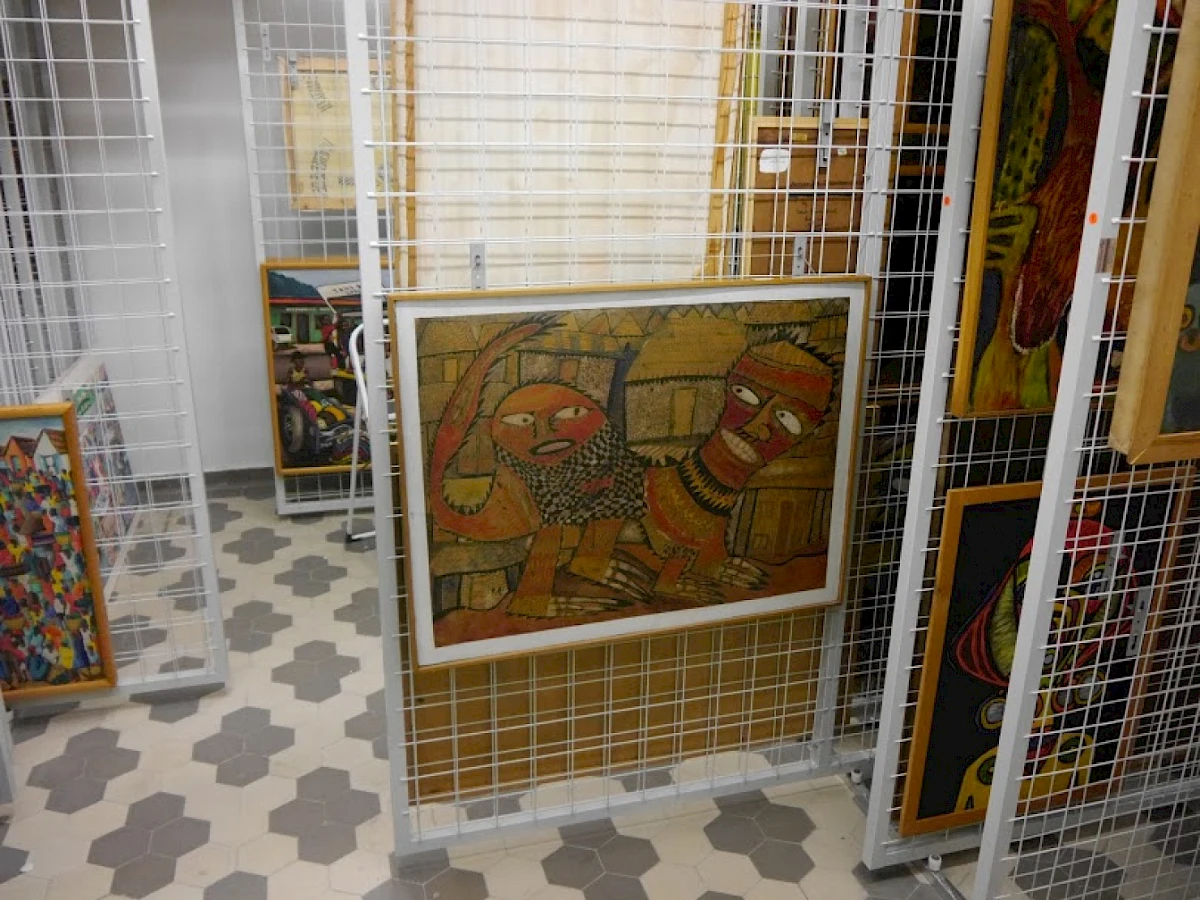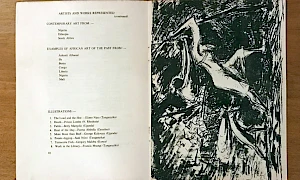
Twins Seven Seven. Devil's Dog. 1966, ink and gouache on paper. Collection Iwalewahaus.
Every institution, every museum or gallery has at least one figurehead, a work with a special history, value or characteristics one is proud to have, an object that is not only shown frequently in exhibitions but also pointing at during visits in the depots. A very personal Mona Lisa, as a colleague called it lately, strongly connected to the institutions' history, claim or principles. Among others, considerable paintings, graphics or sculptures, the artworks of the famous Nigerian artist Twins Seven Seven (1944-2011) are of this special importance to the collection of the Iwalewahaus, a place of production and presentation of contemporary art with its main focus on the African continent. Its collection, which accommodates paintings, graphics, drawings and textiles from 1930 on, can be considered as one of the most important and extensive collections on modern art from Africa in Europe. Founded in 1981 by the German collector and art patron Ulli Beier and the artist Georgina Beier, the Iwalewahaus collection is based on the private collection of the Beiers. One of this pieces I called Iwalewahaus' Mona Lisa, is the work Devil's Dog of Twins Seven Seven from 1966. More precisely, there are two artworks at the Iwalewahaus collection, both titled Devil's Dog and both created by Twins Seven Seven, the first one dated in 1964. Undoubtedly, if I am talking about masterpieces I am speaking about both of them. The story behind those paintings reveal a lot,not only about the artist himself but also about the origination of him being an artist, of his supporters and most interesting in this context about the history of the collection Iwalewahaus.
Prince Taiwo Olaniyi Wyewale-Toyeje Oyekale Osuntoki, Twins Seven Sevens birth name, started his internationally recognized, later on influential career as an artist and painter in the Nigerian town of Oshogbo in 1964, where he met the Beiers for the first time incidentally. He was a dancer and musician before, important origins, which even later on had strong influence on him and his work as an artist. Twins Seven Seven was a Yoruba, an ethnic group in Southwestern and North Central Nigeria, which is known for its variety of different artistic forms including pottery, weaving, beadwork, metalwork, and mask making and its complex mythological and religious system of belief. His first encounter with Ulli Beier happened at the Mbari Mbayo Club, where Beier – impressed by Twins Seven Sevens' personality, as he described it in the biography of the artist that Beier published– convinced him to participate in an artist workshop, held by Georgina Beier in the same year. Influenced by the novels of the Nigerian writer Amos Tutuola and his stories filled with fabulous creatures and fairy worlds of the Yoruba mythology, addressing the spiritual worlds of the gods and their powers, Twins Seven Seven created his first artworks, one of them being a pen and ink drawing, the first Devil's Dog from 1964. Four Devil's Dogs have been created by him in total, two of them until today being part of the collection of Iwalewahaus. In our research project African Art history and the Formation of a modern Aesthetic we closely examined the painting from 1966, ink and gouache on paper, framed probably by Ulli Beier and existing in the collection now since 1981. The work can be considered as a paragon for Twins Seven Sevens artistic oeuvre, his style and formal language as well as the Yoruba-based content, he was almost always referring to. I am calling it Mona Lisa as a metaphor for its importance as it can also be seen as one of the foundation stones of the collection. Furthermore, the famous Oshogbo workshops might be also comparable with first cornerstones for the later institution Iwalewahaus, as careers found their starting points, works were created and networks and relations were built, which partly last until today.
Lena Naumann is Junior Researcher within the project African Art History and the Formation of a Modern Aesthetic.
Further information: https://coamowebcom.wordpress.com/ (Viewed on 29 March 2025)
Related contributions and publications
-

Manifestations of Modernisms – Some thoughts on the histories of exhibitions in the Ugandan context
African Art History and the Formation of a Modern Aesthetic -

A Place of Belonging – The 'Phantasy Africa' within the Archive of the European Art Patrons Ulli and Georgina Beier
African Art History and the Formation of a Modern Aesthetic -

Africa's 1980s: The Intersection of Art, Politics, Economics, and the Social
African Art History and the Formation of a Modern Aesthetic -

Changes and Developments in Uganda's Modern Art
African Art History and the Formation of a Modern Aesthetic -

(Dis-)plays of Modern Art
African Art History and the Formation of a Modern Aesthetic